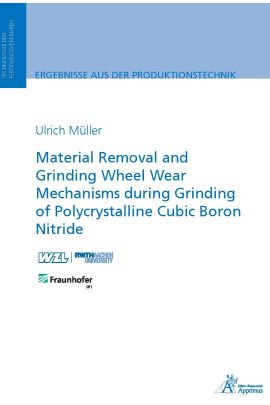Manufacturing companies in the aerospace and automotive industries are facing the challenge of increasing demands on the sustainability of products and production
processes. This leads to a change in the structural materials and is accompanied by a change in the cutting materials used for machining these materials. Due to the increasing requirements in terms of machinability and productivity in the machining of novel materials with geometrically defined cutting edges, the demand for superhard cutting materials is rising. In the segment of indexable inserts for machining of ferrous materials in particular, the demand for polycrystalline cubic boron nitride (pcBN) cutting tools is expected to increase in the coming years. The growing interest in pcBN is driven by low tool wear combined with high productivity. Due to the superior physical properties of pcBN, the manufacturing of tools from pcBN is cost- and time-demanding. In mechanical material removal by grinding, the mechanical properties of pcBN result in low productivity and high grinding wheel wear. In existing approaches to analyze the cause-effect-relationships in grinding of pcBN, thermal loads between the pcBN workpiece and the grinding wheel were not considered yet. Furthermore, only track-bound plunge face grinding of pcBN was considered so far, resulting in a lack of knowledge on track-bound longitudinal face grinding and force-controlled plunge face grinding of pcBN.
Therefore, this thesis involves expanding the existing knowledge on grinding of pcBN with respect to the mechanical and thermal loads in the contact zone between the pcBN workpiece and the grinding wheel, as well as closing the knowledge gap on the process variants of track-bound longitudinal face grinding and force-bound plunge face grinding of pcBN. Therefore, the analysis and modeling of the basic tribological conditions of the frictional contact between diamond and pcBN and the characterization of the thermal and mechanical loads in track-bound longitudinal face grinding as well as in force-controlled plunge face grinding of pcBN are the subject of this work. In order to derive recommendations for the process design of industrial applications, the resulting material removal and grinding wheel wear mechanisms are analyzed and explained based on the thermal and mechanical loads.
| Autor | Müller, Ulrich |
|---|---|
| Gewicht | 0.266 kg |
| Erscheinungsdatum | 01.08.2023 |
Eigene Bewertung schreiben
Technologie der Fertigungsverfahren
Material Removal and Grinding Wheel Wear Mechanisms during Grinding of Polycrystalline Cubic Boron Nitride
ISBN: 978-3-98555-163-7
Lieferzeit: 2-3 Tage
49,00 €
inkl. 7% MwSt.
Kurzbeschreibung
Polycrystalline cubic boron nitride is a superhard cutting material and thus difficult to manufacture. Therefore, the investigation of the cause-effect-relationships during track-bound longitudinal face grinding and force-controlled plunge face grinding of polycrystalline boron nitride is subject of this dissertation. The results are explanatory models for the material removal and grinding wheel wear mechanisms during grinding of polycrystalline cubic boron nitride.
Auf Lager

